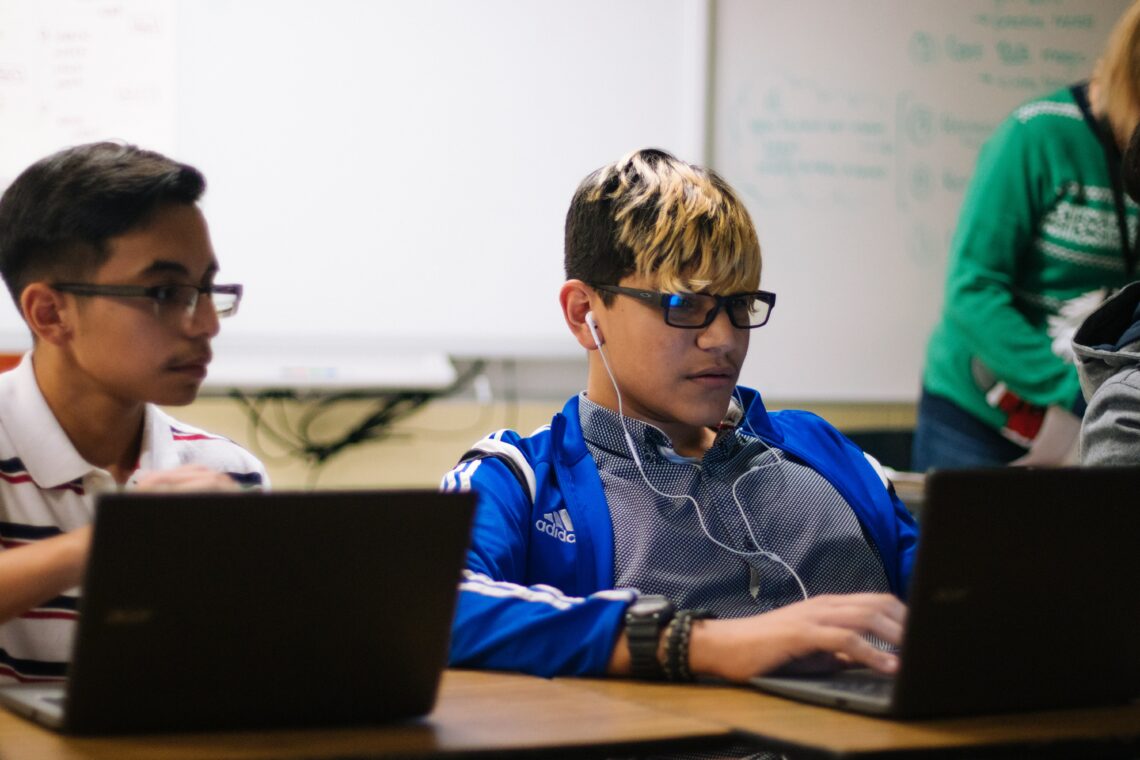How can we productively implement Google Chromebooks in our classrooms?
In looking at using Google Chromebooks in a classroom, it is important to put thought into how you would go about implementing this technology in a productive manner. We have probably all heard the story of a teaching bringing in the huge wheely cart full of computers only for the class to erupt into chaos seeing these novel objects, leaving the teacher defeated. Now, while you may hope for a specific play-by-play of how to implement Chromebooks into your classroom, unfortunately you will not find that here. This is mainly because each person will need to look at the needs of their class to figure out the best implementation process that will actually end up being successful with their unique needs. But, what we are going to look at are some widely discussed major themes to be aware of when implementing Chromebooks – or any technology for that matter – into your classroom. Hopefully this will help to ease any anxiety and frustration in using technology with your students and help to encourage you to create a tech-integrated classroom!
Major Themes:
- Your attitude as the teacher matters
- Learn how to use the technology
- Decrease the novelty
- Establish appropriate boundaries with your students
1. Your attitude as the teacher matters
- A phrase I hear quite often in schools is a student saying “I can’t do that” and then the teacher responding with encouragement by saying “I can’t do that YET.” Vongkulluksn et al., (2018) found that a major affect on the successful implementation of technology in the classroom is the value placed on it by the teacher. If we as a teacher cannot see the value in using technology, and if we approach it with a bad attitude, then it is no surprise that we will fail in implementing it well with our students. As a teacher, find your WHY for using technology in the classroom. Scott Widman has a great TedTalk discussing the importance of technology in the classroom and our obligation to students to use technology in order for them to thrive in this day and age – it may help you understand your why too.
2. Learn how to use the technology
- As Scott Widman says, “technology isn’t a fad,” and so as teachers we really ought to know how to use it! As Sahin et al., (2016) discussed, lack of technological support is definitely a contributor to negative experiences in the implementation of technology in the classroom. In understanding this, one suggestion is to learn how to use the technology in order to help your students use it too! This in no way means that you need to be an expert in all thing’s computers, but for example, if you are wanting to set your students up with Google Classroom, then knowing how to use it would be beneficial for the successful implementation of this tool with your class. There are times when students should be free to experiment, learn new things about tech, and teach YOU, but also realize the balance of when you need to be prepared with knowing how the tech works.
YouTube is a great resource for a teacher who is learning to use new technology!
For example, check out this in-depth video of how to use Google Classroom:
3. Decrease the novelty
- “When technology integration is at its best, a child or a teacher doesn’t stop to think that he or she is using a technology tool – – it is second nature. And students are often more actively engaged in projects when technology tools are a seamless part of the learning process” – Edutopia, 2007
- This quote speaks to this idea that for technology to be really useful for our students, they need to see it as a tool for them to use, and not a toy that comes into our classroom sporadically. If you work in a school with a Chromebook cart, then try reserving it as often as you can in order to normalize having this tool in your classroom. The more students see that the computers are something there to help them with their work, the less of an exciting new thing it will be – hopefully decreasing the novelty of it and increasing student productivity!
4. Establish appropriate boundaries with your students
- In Sahin’s et al., (2016) discussion of technology in the classroom they stated that “insufficient rules and policies allowed students to be distracted with the Chromebook laptops” (p. 373). In implementing any new item into a classroom, there likely needs to be boundaries implemented too. It is important to remember that students may have had a lot of experience with this tool in other classes, or they may have none, but either way, we should establish what our boundaries are in our classroom (obviously while adhering to any school/district policies too) and allow for open dialogue with our students about those boundaries. As was discussed in a presentation with Jesse Miller, it is important that we teach students how to use technology safely because the reality is, it is a part of their lives. In bringing technology into your classroom, this is a perfect time to talk with your students about safety and appropriate boundaries in an open and supportive environment.
Concluding Statement:
Overall, what is important to realize is that the successful implementation of technology in a classroom is not going to be a one-size fits all approach, but rather it is about you as the teacher balancing your understanding and level of comfort with technology with your students’ needs, and then figuring out the best process forward. We must recognize that for some of us it will be much more difficult than for others, but in this day and age it is so important for our students to be digitally literate, and so we as the teacher must work towards allowing a space for that learning in our classroom. The past year has shown us how important technology is in education and has made so many more people aware of the modality in education – prior to this year many people probably only thought of face-to-face learning and homeschooling, but now the terms “hybrid learning” and “online learning” have become ingrained in most of our vocabularies, as they are integral aspects of our education system in this climate. The ability to use video-conferencing and other online platforms for communication with our students, has had an enormous impact on our education system, and without these tools much of the learning that took place this past year, just wouldn’t have. We as teachers must work towards having a tech-integrated classroom which offers students experiences of how to use technology in both productive and explorative ways so that we are greater preparing them for the future of society.
Note: This post was done as one section of a larger exploration into Google Chromebooks! Check out the other three blog posts to learn more here:
- Disadvantages of Chromebooks in the Classroom – Erin VanStone
- Chromebooks:Accessibility – Gabrielle Paulson
- Chrombooks: Apps and Extensions for Educators – Robyn Jellema
References
Edutopia. (2007, November 5). What is successful technology integration?https://www.edutopia.org/technology-integration-guide-description
Sahin, A., Top, N., & Delen, E. (2016). Teachers’ first-year experience with chromebook laptops and their attitudes towards technology integration. Technology, Knowledge and Learning, 21(3), 361-378. https://doi.org/10.1007/s10758-016-9277-9
Vongkulluksn, V. W., Xie, K., & Bowman, M. A. (2018). The role of value on teachers’ internalization of external barriers and externalization of personal beliefs for classroom technology integration. Computers and Education, 118, 70-81. https://doi.org/10.1016/j.compedu.2017.11.009
Photo by Jeswin Thomas on Unsplash






